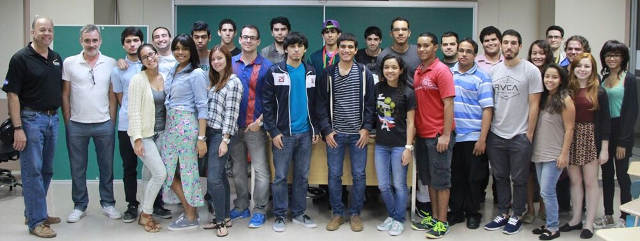XEI Scientific Inc. reports on an exciting collaboration between students from the University of Puerto Rico and NASA.
 Lift-off for one of the RockSat-X projects. Launched from NASA at the Wallops Flight Facility
Lift-off for one of the RockSat-X projects. Launched from NASA at the Wallops Flight Facility
Students from the University of Puerto Rico are going in to space again. For the fifth time in as many years, UPR has had a project selected to be flown from NASA's Wallops Flight Facility as part of an educational project called RockSat-X.
This is designed to provide students hands-on experience in designing, fabricating, testing and conducting experiments for space flight. The project is a national program sponsored by NASA and the Colorado Space Grant Consortium at the University of Colorado at Boulder.
This group has been flying experimental payloads to space since 2007 and this will be their tenth flight through various space educational initiatives. UPR's first RockSat-X project in 2011 used mass spectrometry to conduct an analysis of atmospheric particles and pressure. UPR's next experiment payload included an impact detection system which used a “piezo electric sensor and an aerogel to collect micrometeorites.”
During the next flight, the payload will deploy a sterilized collection system into the space environment which is later retracted and sealed before re-entry. The payload contains organic polymer collectors that will gather amino acids, proteins and DNA to “potentially prove the presence of life at 43 to 100 miles above Earth.” The micro-particles will be analyzed via next-generation genomics.
The Puerto Rico Space Grant Consortium has a participating team made up of interdisciplinary students from several institutions. These include the University of Puerto Rico at Rio Piedras and Mayaguez Campus; the Puerto Rico Department of Education through their Tool and Die School and Marcelino Canino Canino Middle School. A new partnership was formed this year with the Bifrost Corporation with the purpose of going further into research and development of high definition imaging systems for these educational missions.

Members of the team from the University of Puerto Rico.
Oscar Resto is the PI of the UPR RockSat-X program. He is a physicist with more than 35 years experience on experimental physics from vacuum deposition systems and surface science spectroscopy to the innovative Ultra High Transmission Electron Microscopy capable of observing single atoms. Resto says “The RockSat-X program empowers student creativity and propels them into future space development, innovating interdisciplinary STEM concepts into advanced and elaborate experiments. Over the years, the RockSat-X team's experiments have grown into highly complex systems forging more competitive professionals into the new aerospace industry workforce required for space exploration.”
As students prepare for their tenth mission, mechanical engineering student, Alexis Oquendo-Reyes, outlined the plans for this launch.

Student investigator Luis López-Soto with the payload for the flight. He is studying electrical engineering.
“A key distinction between the 2014 and 2015 payloads is the further incorporation of procedures for mitigating cross-contamination. Since we will be collecting organic samples, we need to make sure that these samples are from outer space and not from the Earth. In this second 2015 experiment, the main method of decontamination will be the use of plasma with the Evactron® ES Decontaminator. Collecting samples is not our only experiment. We will also be measuring temperature (and possibly pressure) changes throughout the flight and recording the flight in high definition.”
The Evactron® ES Decontamination System is a product from XEI Scientific, an established US instrument supplier based in Redwood City, CA. Vice President of Worldwide Sales, Dan Kleinen, says, “we at XEI are proud to help the students in their quest to advance their knowledge of the space industry and we'll be watching closely when the rocket lifts off from NASA's Wallops Flight Facility in Virginia later in the year.”
To learn about the mission, go to the RockSat-X Mission home page. To find out about XEI and their Evactron® Decontamination systems, visit www.evactron.com.
About XEI Scientific, Inc.
XEI Scientific Inc. invented the Evactron De-Contaminator in 1999 as the first plasma cleaner to use a downstream cleaning process to remove carbon from electron microscopes. A proprietary plasma source uses air to produce oxygen radicals for oxidation of carbon compounds for removal by the pumps. Carbon-free-vacuum produces the highest quality images and analytical results from SEMs and other vacuum analytical instruments. XEI innovations also include a unique RF plasma generator, a patented RF electrode, and easy start programmed plasma cleaning. All XEI products come with a 5 year limited warranty and are compliant with CE, NRTL, and Semi-S2 safety standards. XEI offers a variety of Evactron® decontamination systems to meet user needs and >2000 installations around the world. For more information on products and services offered by XEI Scientific, Inc., see www.evactron.com